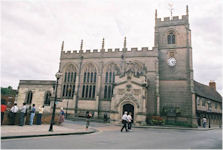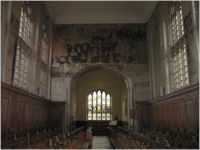

Figure 1: The Guild Chapel, Stratford-upon-Avon
Figure 2: The interior of the Guild Chapel, Stratford-upon-Avon
The Chapel of the Guild of the Holy Cross (hereafter referred to as the Guild Chapel) stands at the corner of Church Street and Chapel Lane in Stratford-upon-Avon, Warwickshire, England (Figure 1). Today, the building is part of the 'tourist trail', visited because of its proximity to William Shakespeare's former home, 'New Place', and maintained by The Friends of the Guild Chapel. The appearance of the building owes much to a major restoration programme carried out between 1955-62, which resulted in the re-facing of the stonework and rebuilding of the north porch. Inside, its scrubbed walls bear only the slight traces of its former decoration, most obviously the rather faint 'Doom' painting over the chancel arch (Figure 2). However, the Stratford Guild chapel is a building of international significance; one of the finest examples in Europe of a purpose-built medieval guild chapel which was rebuilt and redecorated in the late 15th century with a scheme of wall paintings commissioned by the London Mayor and Stratford merchant, Hugh Clopton. The reconstruction of this scheme reveals it to be one of the most important of its type, and one of the most interesting examples of the mercantile patronage of the arts in late medieval England. The analysis of the scheme also sheds important new light on the dissemination of late-medieval iconographies such as 'The Dance of Death' from Europe into England.


Figure 1: The Guild Chapel, Stratford-upon-Avon
Figure 2: The interior of the Guild Chapel, Stratford-upon-Avon
This article commences with an introduction to Stratford-upon-Avon, the Guild of the Holy Cross and its buildings. It then provides a detailed discussion of the digital model which forms the focus of the Stratford project. This is a ground-breaking example of how heritage technologies can be channelled to create digital models as research tools for historical archaeology. At Stratford-upon-Avon, this is achieved through the creation of a layered 'palimpsest' of antiquarian drawings of the Chapel and its paintings, presented in a 3-dimensional architectural context within the model, which can be analysed by the user. The unique structural possibilities of the Internet Archaeology format are then harnessed to present the 'paradata' behind the digital model, not as a series of technical files or appendices, but rather as the core of the scholarly argument and discussion within the text. Thus, the drawings presented in the model are supported by a consideration of the biography and recording methods of the individual antiquarians who created them, while the iconography of the scheme is considered in a comparative, contextual analysis of the model itself. Hyperlinks within each section and further images included within the article allow the user to explore connections within and between the recorder and the records, following the research process of the project team. What emerges is not a single, static, photorealistic model of Stratford-upon-Avon's Guild Chapel, but rather a dynamic and interactive research resource which addresses issues such as transparency and paradata within the field of heritage technology. While the article provides an innovative model for the use of digital visualisations within historical archaeology, it is therefore also of wider significance as an example of the way in which digital technologies can be harnessed within the arts and humanities more widely.
© Internet Archaeology/Author(s)
University of York legal statements | Terms and Conditions
| File last updated: Tue Jul 25 2012